 Why we're supporting work to bring mental health resources to teenagers directly in their classrooms.
Why we're supporting work to bring mental health resources to teenagers directly in their classrooms.
A new effort to support teen mental health
 Why we're supporting work to bring mental health resources to teenagers directly in their classrooms.
Why we're supporting work to bring mental health resources to teenagers directly in their classrooms.
 Why we're supporting work to bring mental health resources to teenagers directly in their classrooms.
Why we're supporting work to bring mental health resources to teenagers directly in their classrooms.
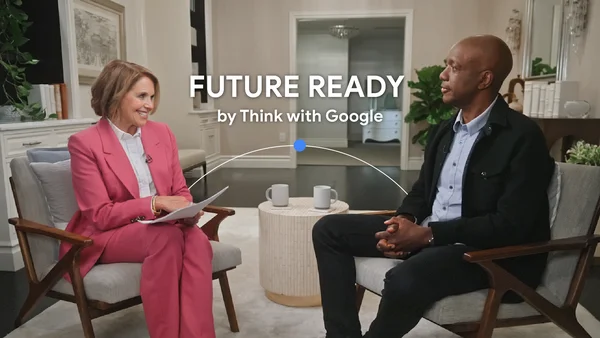 Katie Couric hosts Future Ready by Think with Google, a new interview series featuring experts in AI, cybersecurity and psychology.
Katie Couric hosts Future Ready by Think with Google, a new interview series featuring experts in AI, cybersecurity and psychology.
 Katie Couric hosts Future Ready by Think with Google, a new interview series featuring experts in AI, cybersecurity and psychology.
Katie Couric hosts Future Ready by Think with Google, a new interview series featuring experts in AI, cybersecurity and psychology.
We're committed to building products that are secure by default, private by design, and that put people in control. And while our policies don’t allow kids under 13 to create a standard Google account, we’ve worked hard to design enriching product experiences specifically for them, teens, and families. Through Family Link, we allow parents to set up supervised accounts for their children, set screen time limits, and more. Our Be Internet Awesome digital literacy program helps kids learn how to be safe and engaged digital citizens; and our dedicated YouTube Kids app, Kids Space and teacher approved apps in Play offer experiences that are customized for younger audiences.
Technology has helped kids and teens during the pandemic stay in school through lockdowns and maintain connections with family and friends. As kids and teens spend more time online, parents, educators, child safety and privacy experts, and policy makers are rightly concerned about how to keep them safe. We engage with these groups regularly, and share these concerns.
Some countries are implementing regulations in this area, and as we comply with these regulations, we’re looking at ways to develop consistent product experiences and user controls for kids and teens globally. Today, we’re announcing a variety of new policies and updates:
Giving minors more control over their digital footprint
While we already provide a range of removal options for people using Google Search, children are at particular risk when it comes to controlling their imagery on the internet. In the coming weeks, we’ll introduce a new policy that enables anyone under the age of 18, or their parent or guardian, to request the removal of their images from Google Image results. Of course, removing an image from Search doesn’t remove it from the web, but we believe this change will help give young people more control of their images online.
Tailoring product experiences for kids and teens
Some of our most popular products help kids and teens explore their interests, learn more about the world, and connect with friends. We’re committed to constantly making these experiences safer for them. That’s why in the coming weeks and months we're going to make a number of changes to Google Accounts for people under 18:
YouTube: We’re going to change the default upload setting to the most private option available for teens ages 13-17. In addition we’ll more prominently surface digital wellbeing features, and provide safeguards and education about commercial content. Learn more about these changes here.
Search: We have a range of systems, tools and policies that are designed to help people discover content from across the web while not surprising them with mature content they haven’t searched for. One of the protections we offer is SafeSearch, which helps filter out explicit results when enabled and is already on by default for all signed-in users under 13 who have accounts managed by Family Link. In the coming months, we’ll turn SafeSearch on for existing signed-in users under 18 and make this the default setting for teens setting up new accounts.
Assistant: We are always working to prevent mature content from surfacing during a child’s experience with Google Assistant on shared devices, and in the coming months we’ll be introducing new default protections. For example, we will apply our SafeSearch technology to the web browser on smart displays.
Location History: Location History is a Google account setting that helps make our products more useful. It's already off by default for all accounts, and children with supervised accounts don’t have the option of turning Location History on. Taking this a step further, we’ll soon extend this to users under the age of 18 globally, meaning that Location History will remain off (without the option to turn it on).
Play: Building on efforts like content ratings, and our "Teacher-approved apps" for quality kids content, we're launching a new safety section that will let parents know which apps follow our Families policies. Apps will be required to disclose how they use the data they collect in greater detail, making it easier for parents to decide if the app is right for their child before they download it.
Google Workspace for Education: As we recently announced, we’re making it much easier for administrators to tailor experiences for their users based on age (such as restricting student activity on YouTube). And to make web browsing safer, K-12 institutions will have SafeSearch technology enabled by default, while switching to Guest Mode and Incognito Mode for web browsing will be turned off by default.
New advertising changes
We’ll be expanding safeguards to prevent age-sensitive ad categories from being shown to teens, and we will block ad targeting based on the age, gender or interests of people under 18. We’ll start rolling out these updates across our products globally over the coming months. Our goal is to ensure we’re providing additional protections and delivering age-appropriate experiences for ads on Google.
New digital wellbeing tools
In Family Link, parents can set screen time limits and reminders for their kids’ supervised devices. And, on Assistant-enabled smart devices, we give parents control through Digital Wellbeing tools available in the Google Home app. In the coming months, we’ll roll out new Digital Wellbeing filters that allow people to block news, podcasts, and access to webpages on Assistant-enabled smart devices.
On YouTube, we’ll turn on take a break and bedtime reminders and turn off autoplay for users under 18. And, on YouTube Kids we’ll add an autoplay option and turn it off by default to empower parents to make the right choice for their families.
Transparency Resources: The Family Link Privacy Guide for Children and Teens and the Teen Privacy Guide
Improving how we communicate our data practices to kids and teens
Data plays an important role in making our products functional and helpful. It’s our job to make it easy for kids and teens to understand what data is being collected, why, and how it is used. Based on research, we’re developing engaging, easy-to-understand materials for young people and their parents to help them better understand our data practices. These resources will begin to roll out globally in the coming months.
Ongoing work to develop age assured product experiences
We regularly engage with kids and teens, parents, governments, industry leaders, and experts in the fields of privacy, child safety, wellbeing and education to design better, safer products for kids and teens. Having an accurate age for a user can be an important element in providing experiences tailored to their needs. Yet, knowing the accurate age of our users across multiple products and surfaces, while at the same time respecting their privacy and ensuring that our services remain accessible, is a complex challenge. It will require input from regulators, lawmakers, industry bodies, technology providers, and others to address it – and to ensure that we all build a safer internet for kids.
Posted by Mindy Brooks, General Manager, Kids and Families
In early March 2020, we conducted a survey to better understand people’s digital wellbeing and tech use. Shortly after, daily life took a turn as the COVID-19 pandemic surged and shelter-in-place orders went into effect in many places throughout the United States. Given that change, we decided to do the survey again in September to check in and see how families' digital wellbeing might have changed.
While these surveys represent a relatively small sample size of the U.S. population, they still provide valuable insight into recent behavioral trends and add to the ongoing conversation about tech use and mental wellbeing. When comparing the results, we saw some interesting changes to how parents are managing tech for themselves and for their children.
We saw that parents are struggling more now to maintain healthy digital habits for their kids:
While our research revealed these challenges, we also saw that some parts of these families’ overall digital wellbeing have improved:
Everyone—children included—are inevitably spending more time online, and there are a handful of Google tools that can help the entire family with this increase. For example, the Family Link app helps you figure out what digital ground rules work best for your family, while also allowing you to keep an eye on kids’ tech use. The kids tab in Google Play features “teacher-approved apps” that are both enriching and fun. And Google Kids Space, a new experience available on select Android tablets, has tons of apps, books and videos for kids to discover. And there are also lots of ways parents can use our digital wellbeing features to take breaks from their devices, unwind for a better night’s rest and ultimately model better tech habits for the family.
Seeing the changes in the survey results helped us discover more about families and their tech use, and there’s still so much to learn. As we continue exploring this space, we’ll provide more learnings, tools and resources to support the unfolding changes. Learn more about our digital wellbeing resources at wellbeing.google.
Methodology: Findings are based on results of two separate online surveys conducted by Savanta, a Next15 company. Wave 1 was conducted in February and March 2020; wave 2 was conducted in September 2020. Although wave 2 was shorter than wave 1, for comparability purposes, questions asked and audiences surveyed remained consistent. The online surveys were conducted among n=1,000 (wave 1) and n=500 (wave 2) respondents, respectively. The sample was nationally representative as it relates to age, gender, household income, race/ethnicity and region. Half (50 percent) of the sample consisted of parents with at least one child under 18 and three-quarters (75 percent) of these parents have children under the age of 13 living with them. The margin of error for the total sample at the 95 percent confidence level is +/- 3.1 percentage points for wave 1 and +/-4.4 percentage points for wave 2.
In early March 2020, we conducted a survey to better understand people’s digital wellbeing and tech use. Shortly after, daily life took a turn as the COVID-19 pandemic surged and shelter-in-place orders went into effect in many places throughout the United States. Given that change, we decided to do the survey again in September to check in and see how families' digital wellbeing might have changed.
While these surveys represent a relatively small sample size of the U.S. population, they still provide valuable insight into recent behavioral trends and add to the ongoing conversation about tech use and mental wellbeing. When comparing the results, we saw some interesting changes to how parents are managing tech for themselves and for their children.
We saw that parents are struggling more now to maintain healthy digital habits for their kids:
While our research revealed these challenges, we also saw that some parts of these families’ overall digital wellbeing have improved:
Everyone—children included—are inevitably spending more time online, and there are a handful of Google tools that can help the entire family with this increase. For example, the Family Link app helps you figure out what digital ground rules work best for your family, while also allowing you to keep an eye on kids’ tech use. The kids tab in Google Play features “teacher-approved apps” that are both enriching and fun. And Google Kids Space, a new experience available on select Android tablets, has tons of apps, books and videos for kids to discover. And there are also lots of ways parents can use our digital wellbeing features to take breaks from their devices, unwind for a better night’s rest and ultimately model better tech habits for the family.
Seeing the changes in the survey results helped us discover more about families and their tech use, and there’s still so much to learn. As we continue exploring this space, we’ll provide more learnings, tools and resources to support the unfolding changes. Learn more about our digital wellbeing resources at wellbeing.google.
Methodology: Findings are based on results of two separate online surveys conducted by Savanta, a Next15 company. Wave 1 was conducted in February and March 2020; wave 2 was conducted in September 2020. Although wave 2 was shorter than wave 1, for comparability purposes, questions asked and audiences surveyed remained consistent. The online surveys were conducted among n=1,000 (wave 1) and n=500 (wave 2) respondents, respectively. The sample was nationally representative as it relates to age, gender, household income, race/ethnicity and region. Half (50 percent) of the sample consisted of parents with at least one child under 18 and three-quarters (75 percent) of these parents have children under the age of 13 living with them. The margin of error for the total sample at the 95 percent confidence level is +/- 3.1 percentage points for wave 1 and +/-4.4 percentage points for wave 2.
In early March 2020, we conducted a survey to better understand people’s digital wellbeing and tech use. Shortly after, daily life took a turn as the COVID-19 pandemic surged and shelter-in-place orders went into effect in many places throughout the United States. Given that change, we decided to do the survey again in September to check in and see how families' digital wellbeing might have changed.
While these surveys represent a relatively small sample size of the U.S. population, they still provide valuable insight into recent behavioral trends and add to the ongoing conversation about tech use and mental wellbeing. When comparing the results, we saw some interesting changes to how parents are managing tech for themselves and for their children.
We saw that parents are struggling more now to maintain healthy digital habits for their kids:
While our research revealed these challenges, we also saw that some parts of these families’ overall digital wellbeing have improved:
Everyone—children included—are inevitably spending more time online, and there are a handful of Google tools that can help the entire family with this increase. For example, the Family Link app helps you figure out what digital ground rules work best for your family, while also allowing you to keep an eye on kids’ tech use. The kids tab in Google Play features “teacher-approved apps” that are both enriching and fun. And Google Kids Space, a new experience available on select Android tablets, has tons of apps, books and videos for kids to discover. And there are also lots of ways parents can use our digital wellbeing features to take breaks from their devices, unwind for a better night’s rest and ultimately model better tech habits for the family.
Seeing the changes in the survey results helped us discover more about families and their tech use, and there’s still so much to learn. As we continue exploring this space, we’ll provide more learnings, tools and resources to support the unfolding changes. Learn more about our digital wellbeing resources at wellbeing.google.
Methodology: Findings are based on results of two separate online surveys conducted by Savanta, a Next15 company. Wave 1 was conducted in February and March 2020; wave 2 was conducted in September 2020. Although wave 2 was shorter than wave 1, for comparability purposes, questions asked and audiences surveyed remained consistent. The online surveys were conducted among n=1,000 (wave 1) and n=500 (wave 2) respondents, respectively. The sample was nationally representative as it relates to age, gender, household income, race/ethnicity and region. Half (50 percent) of the sample consisted of parents with at least one child under 18 and three-quarters (75 percent) of these parents have children under the age of 13 living with them. The margin of error for the total sample at the 95 percent confidence level is +/- 3.1 percentage points for wave 1 and +/-4.4 percentage points for wave 2.
Since the dawn of the front-facing camera, and even before it, selfies have been a crucial way we express ourselves. So crucial, in fact, that more than 70 percent of photos taken on an Android device use the front-facing camera, and over 24 billion photos have been labeled as selfies in Google Photos. And of course, emojis, filters, stickers and captions have all become part of the fun, and help us show what we're feeling and thinking at any given moment.
Filters have rapidly increased in popularity over the past few years. Many of us love to play around with filters and try different ones on our photos—but sometimes, filters are turned on by default in our photo apps without our knowing.
We set out to better understand the effect filtered selfies might have on people’s wellbeing—especially when filters are on by default. We conducted multiple studies and spoke with child and mental health experts from around the world, and found that when you’re not aware that a camera or photo app has applied a filter, the photos can negatively impact mental wellbeing. These default filters can quietly set a beauty standard that some people compare themselves against.
To put our research into practice, we created a framework to build and design products that support your wellbeing as well as an intentional relationship with technology. These people-centered guidelines inform and respect your personal choices regarding face retouching and center around control, transparency and design language. This means you should get to choose if and when your appearance is changed in pictures.
These guidelines suggest that face retouching settings should be off by default so you choose when you want to turn them on. If face retouching filters are on, this should be clearly indicated in the product experience. And when it’s off, it should stay off. We’ve steered away from references to “beauty,” by using iconography and language that is value-neutral, so you can decide what retouching means to you.
With Google’s Pixel phones, we’ve begun to apply these design principles directly within the Camera app. Starting with the Pixel 4a, the new Pixel 4a (5G) and Pixel 5, face retouching options are available in the camera app, but turned off by default. In an upcoming update, you’ll see value-free, descriptive icons and labels for face retouching options. And if you choose to use face retouching effects, you’ll see more information about how each setting is applied and what changes it makes to your image.
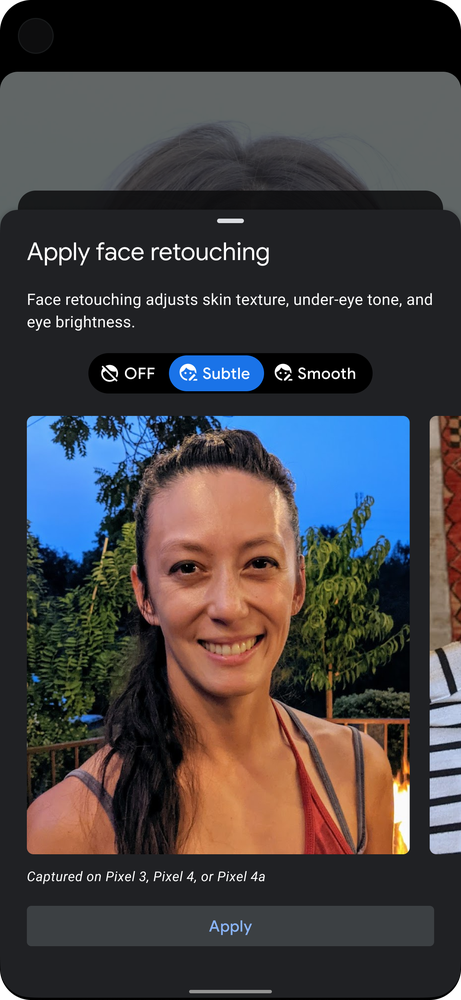
Meaningful change takes collective effort, across a broad ecosystem of apps and devices. Our partners have shared customer feedback that echoes what we heard in our research, and we’ve shared our insights and design framework with them as they continue to find ways to update their product experiences as well.
An app that shares our beliefs is Snapchat. Their default camera experience is always unfiltered, and you have the option to opt-in to lenses. Lens Studio also uses value-neutral terms for its facial retouching feature, and is committed to continuing to make improvements in this area.
These are the first of many steps we’re taking to support wellbeing and bring your voice into our design process.
If you’ve seen your weekly screen time go up over the past few months, you’re hardly alone. Maggie Stanphill, Google’s director of user experience (UX), has seen her stats go up, too. Maggie leads UX efforts for Google’s Digital Wellbeing initiative, and she’s noticed that the current state of the world requires an evolution in our understanding of how we can mindfully use tech.
“The emphasis on screen time feels really tone deaf right now, right?” Maggie says. “Almost everyone who has access to tech is spending more and more time online. So many of us are getting those weekly screen time reports that say it’s gone up by some percent, and that might actually be aggravating.” But, she explains, there are ways digital tools can be more helpful. “We’re really trying to create a more nuanced approach. Look at sleep: We know queries for insomnia have gone way up, and we’re working on refining our tools to support that.”
I recently sat down with Maggie via Google Meet to talk more about her work in UX, and how Google’s Digital Wellbeing features are pivoting to meet people where they are.
How would you describe your job at a dinner party to someone who doesn’t work in tech?
I’d say we conduct research with people around the world to better understand their needs and bring that perspective into the product design process to make tech more helpful and less intrusive. I also like to say that you can think of a UXer as the voice of the user in the room where decisions are being made. That’s where we play a role to advocate for people’s needs.
What was your career path to UX like?
I started as a journalist, actually; I got a degree in English. I loved storytelling, and I really found there was a natural transition when I moved into this field—storytelling was part of the design process. Narrative showed up in a variety of ways, like conducting ethnographic research and sharing people’s perspectives through tools like personas, which are character sketches that help UXers understand their core audience. Having that people-first lens is what’s really driven my career path. There was no “UX degree” when I was going through school, but I’ve found that focusing on understanding people’s needs and their goals translated really well in terms of what I needed to grow and be effective at this work.
Have you heard of the Strengths Finder quiz?
I’ve heard of it but I haven’t taken it!
One of my primary strengths is “input,” information gathering and synthesizing. I’m organizing information every day, in my brain and in Google Docs! It’s part of my process. I have to internalize things to feel like I can be fluent and translate those concepts to make sure our products are building toward a shared strategy and are easy to use.
What specifically are you working on at Google right now?
My focus is two-fold. I work in an advocate role for the company-wide digital wellbeing initiative, and I also manage our Fit UX team. My interest in people and human behavior is very much what drew me to digital wellbeing. For the past two years we’ve spent our time defining what “digital wellbeing” means. More recently, we’ve tried to pivot from a focus on screen time as the most important metric to really empowering people by default. What I mean by that is there are ways we as product designers can build wellbeing into our product experiences, so people don’t have so much to worry about when it comes to using tech. Because we’re a cross-Google team, we’re really focused on providing expertise from a research-based set of best practices. So we established a digital wellbeing toolkit, which includes four key tenets: empowerment, awareness, control and adaptability, and applied those in a variety of ways.
How do those tenets show up in products?
Sleep is a great example of how people’s fundamental needs drive Google’s product priorities. Sleep is so critical to overall wellbeing, and we’ve heard from people all over the world that they’re not getting enough of it. We imagined we could help people get more sleep by making our products more adaptable. You look at Android, Google Assistant and YouTube and realize that if they were more coordinated they could work together to help people get more sleep. That’s when we came up with Bedtime mode, which uses Clock to set your preferred schedule. That schedule then activates features like Grayscale and Do Not Disturb to help you disconnect, and stay that way.
The underlying tenet that makes this work is adaptability, where each experience takes the person’s preferences into account; in this case, that preference is their bedtime schedules. Then all the devices and apps adjust to support those needs: Your bedtime clock notifies you to wind down, apps turn to Grayscale, and when your phone docks, it goes into Do Not Disturb automatically. Google Assistant also has a Bedtime routine that follows this schedule.
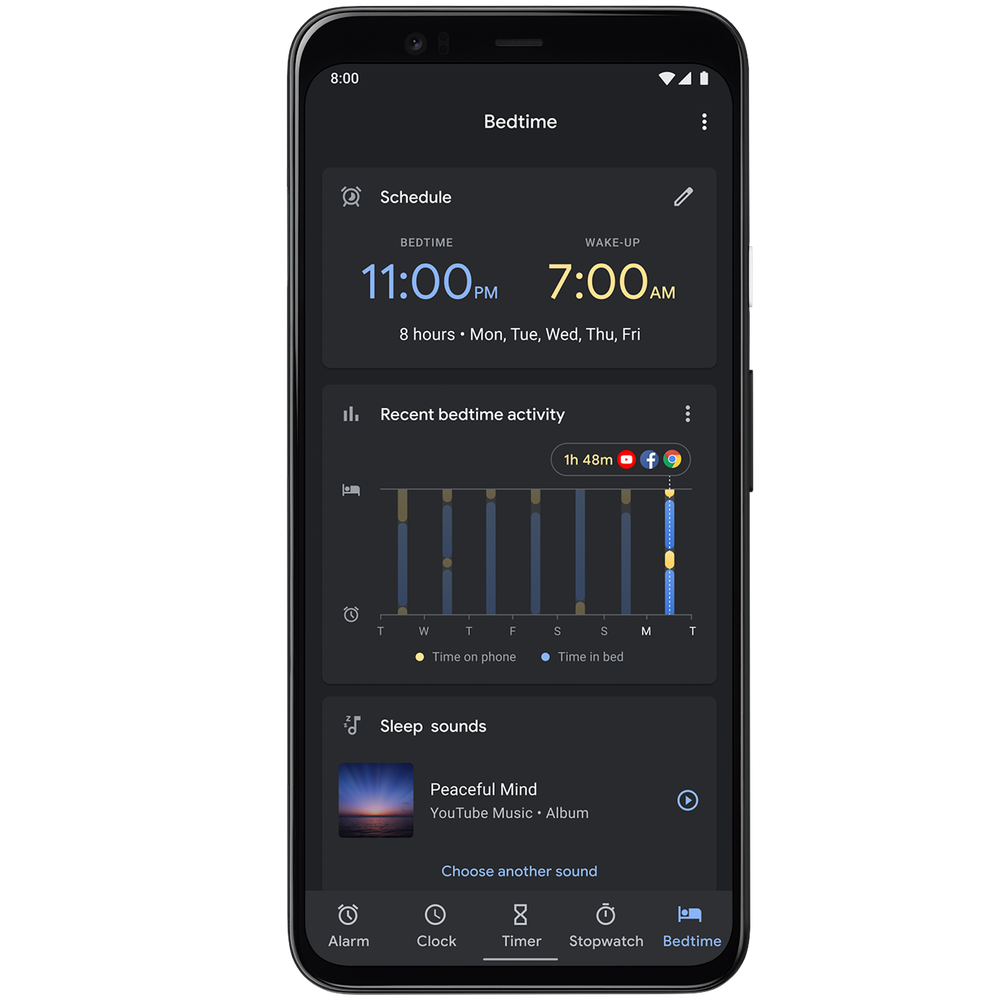
In your digital wellbeing research, is there anything that’s really surprised you?
Maybe it’s not fully surprising in the canon of human behavior, but in our annual survey of user sentiment, it always strikes me that people have more concern about others’ use of tech than their own. There’s a higher percentage of care related to their loved ones’ tech use, but when it comes to reflecting on their own, that percentage of care is much lower. We have a hard time seeing and changing our own behavior.
Has quarantine changed your thinking about digital wellbeing at all, or made anything more clear to you?
Aside from shifting the focus from screen time to positive use of tech, the other thing that jumped off the page for me is the interplay between digital access and mental health. We’ve seen an increase in people’s feelings of disconnection from others due to social isolation, and therefore, the use of tech is seen as positive because it helps them feel more connected. On the other hand, we’ve seen early indicators that income and race may determine a person’s access to tech, and that access can play a role in wellbeing. For example, certain populations are suffering from shared grief, given some of the recent health and recent events, and they can benefit from more digital tools that help with communication, mental health and more. Yet this gap remains between access to information and tools to support wellbeing. And we’re looking into ways to bridge that divide.
With sleep, the quality is just as important as the quantity. Right now, those of us who no longer commute and are staying close to home may be able to sleep in, but how well and how much we’re sleeping can still be a struggle. In fact, there’s been a rise in sleep-related searches like “insomnia” and “can’t sleep,” which reached all-time highs in April and May. At Google, we believe that technology should improve life, not distract from it–including your sleep. Today we’re sharing a few tips and new bedtime tools to help you get better and more restful sleep.
A dark, quiet environment can help with falling and staying asleep. With Bedtime mode, formerly known as Wind Down in the Digital Wellbeing settings, your Android phone can stay dark and quiet while you sleep. While Bedtime mode is on, it uses Do Not Disturb to silence calls, texts and other notifications that might disturb your sleep. Grayscale fades the colors on your phone to black and white to reduce the draw from enticing colors that keep you up.
We’ve now made it easier to customize how and when you turn on Bedtime mode. Based on your bedtime schedule, you can choose to have it turn on automatically or after your phone is plugged in to charge. You can also add Bedtime mode to your phone's Quick Settings panel to instantly turn it on or off with a single tap. And if you need a few more minutes, you can pause Bedtime mode without needing to adjust your schedule. Bedtime mode is available on all devices with Digital Wellbeing and parental controls settings.
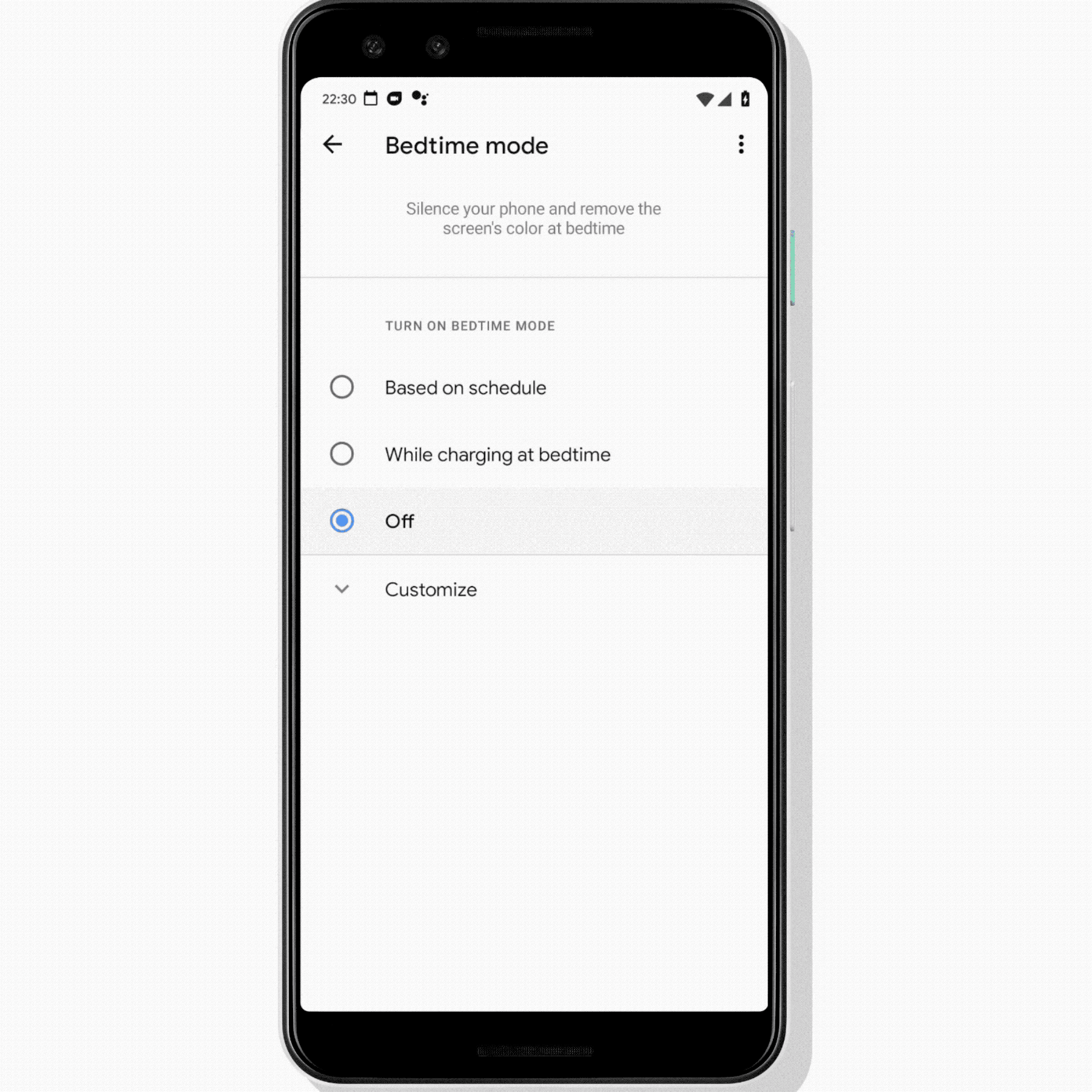
Bedtime mode limits interruptions by keeping your phone dark and quiet.
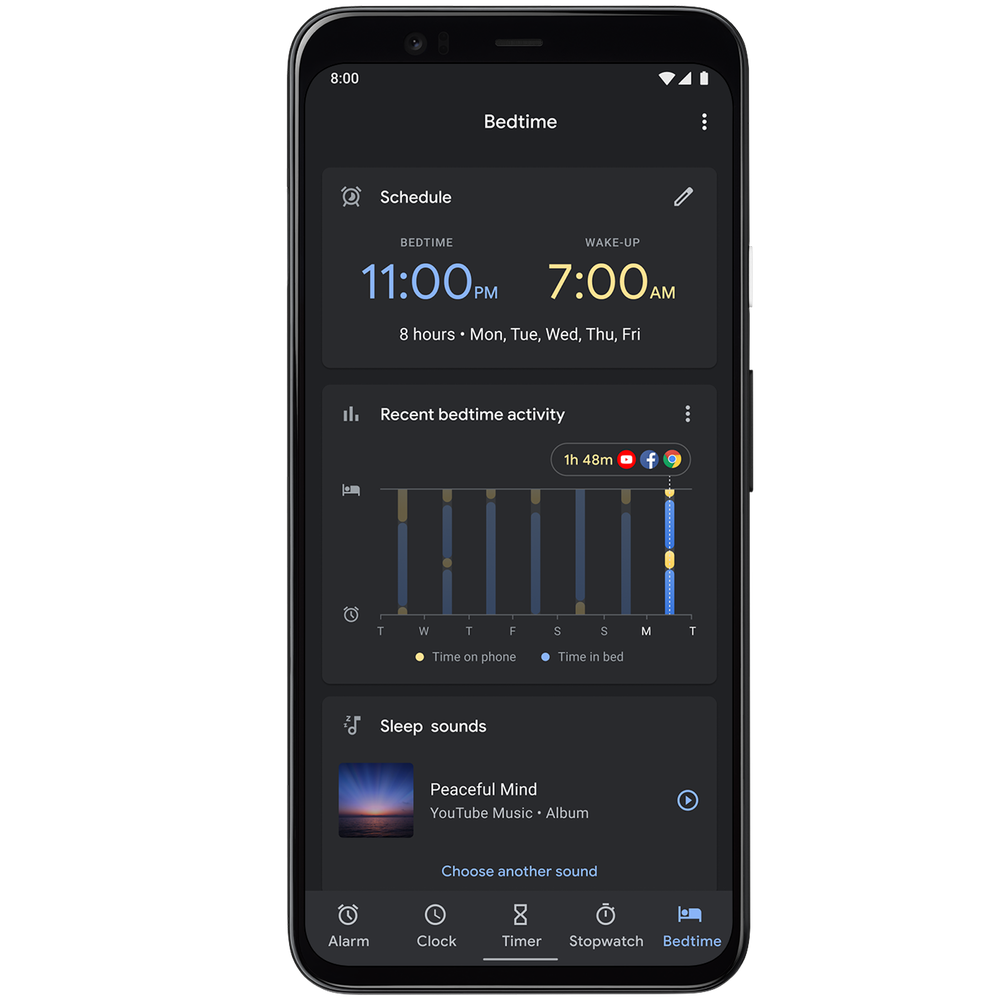
Set a sleep schedule and see your bedtime habits with the new Bedtime tab in Clock.
While sticking to a schedule is something to strive for, real life often requires flexibility. It’s helpful to start with a wake-up time and work backwards when you set your bedtime schedule. In Clock, you’ll see a preview of tomorrow’s calendar and a tally of the total hours of sleep you’d get, and you can adjust your bedtime if needed.
To help you get to bed and fall asleep, you’ll receive a reminder before bedtime and an option to play calming sounds from Calm, Spotify, YouTube Music and more. For those with Digital Wellbeing installed, you can pair with Bedtime mode to limit interruptions while you sleep. And if you happen to stay on your phone later than planned, you can see how much time you’re spending and which apps you’ve used after your set bedtime.
Being woken up by an alarm can be jarring. To avoid interrupting deep sleep and wake up more gently, the Sunrise Alarm gives a visual cue that your wake up time is approaching, 15 minutes prior to your audio alarm. Make it an even more pleasant experience by adding your favorite song or sounds.
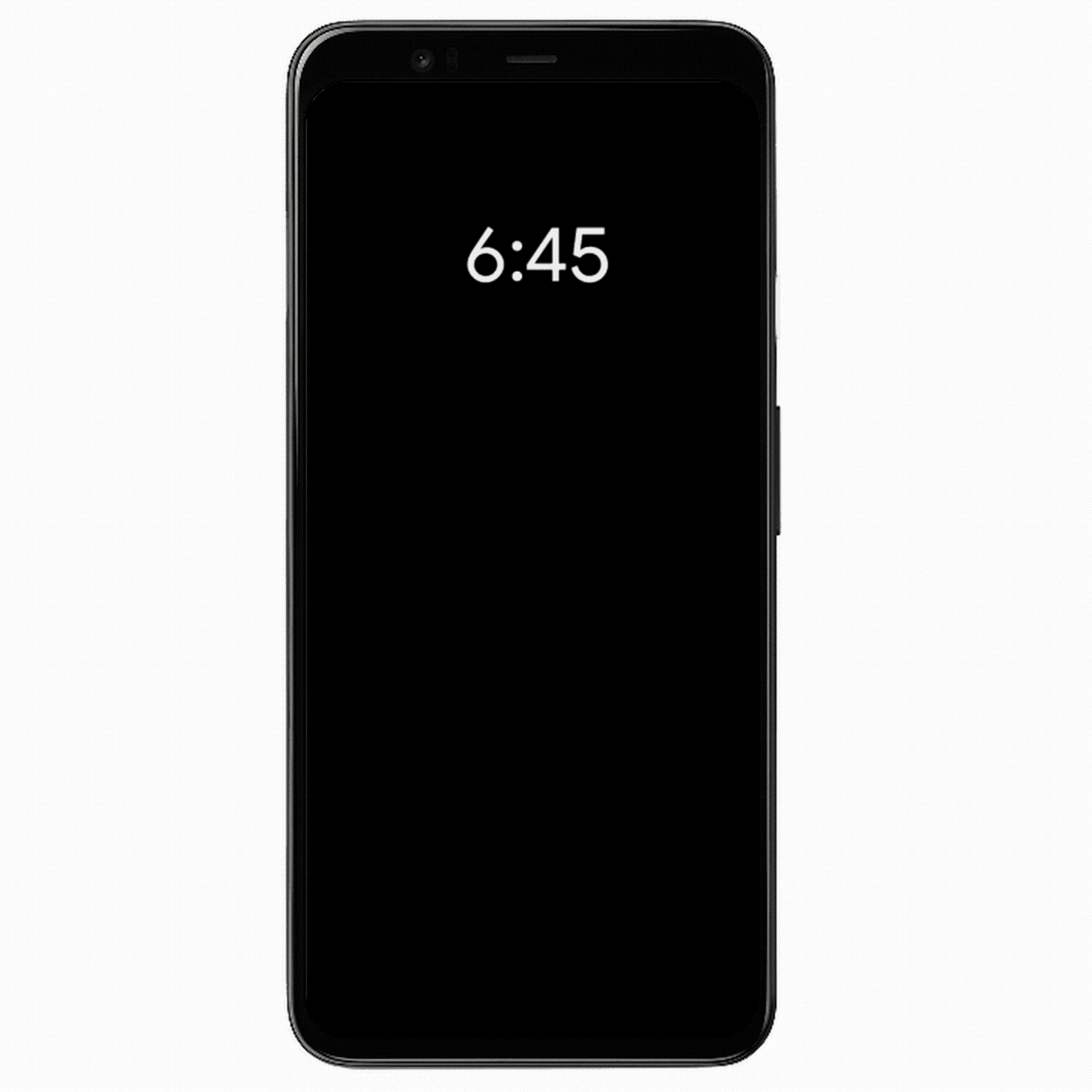
The Sunrise Alarm gradually brightens your screen to help you wake up gently.
The new bedtime experience is rolling out to Pixel devices starting today and will be available in the Clock app on other Android devices later this summer.
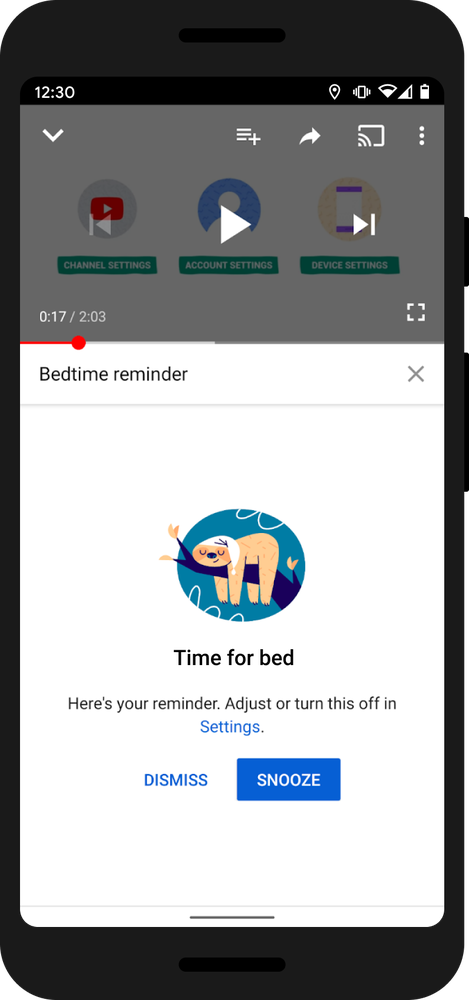
YouTube’s bedtime reminders make it easier to set helpful boundaries.
Family Link helps you set digital ground rules for your children, including managing their screen time activity, app downloads, in-app purchases and even bedtime for their device. You can create a daily bedtime schedule, adjusting it on certain days or weekends as needed. Once bedtime rolls around, your child’s device will lock, but will still allow calls in case your child needs to reach you.
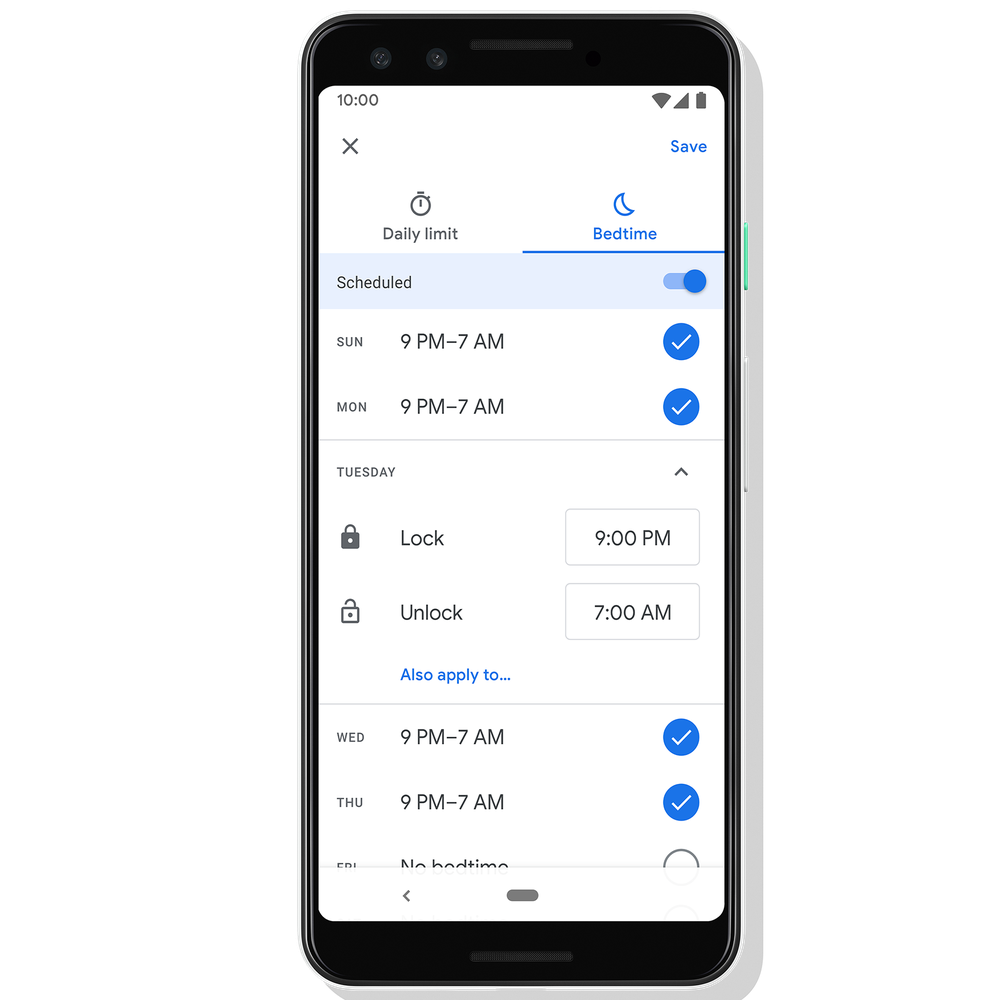
With Family Link, you can lock your child’s device at bedtime.
We hope these bedtime tools can help you and your family unplug and get the consistent, restful sleep you need.